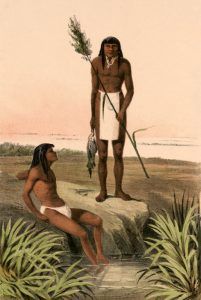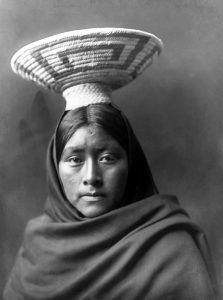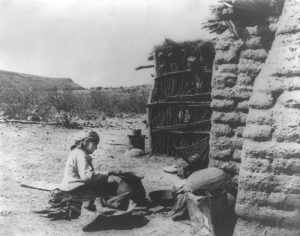The Tohono O’odham people also referred to as the Papago, are a Native American tribe of the Sonoran Desert who primarily live in Arizona and the Mexican state of Sonora. Tohono O’odham means “Desert People.” When the Spanish came upon them, they called them Papago, but the people rejected this name and officially changed it to Tohono O’odham in the 1980s.
They are thought to be descendants of the prehistoric Hohokam culture. They share linguistic and cultural roots with the closely related Akimel O’odham or Pima people, whose lands lie just south of present-day Phoenix along the lower Gila River.
These people were a settled tribe that raised crops, including sweet Indian corn, beans, squash, lentils, and melons. They also took advantage of native plants, such as saguaro fruits, mesquite tree beans, and cholla buds, and made mesquite candy from the sap of mesquite trees.
Mission San Xavier del Bac near Tucson, founded in 1700 by the Jesuit missionary and explorer Eusebio Kino, was built by the Tohono O’odham. Though the Catholic priests were there to Christianize the area Indians, the Tohono O’odham villages resisted change for hundreds of years. During the 1660s and 1750s, two major rebellions rivaled in scale the 1680 Pueblo Revolt. During and after Spanish rule, the desert people preserved their traditions largely intact for generations. Today, the beautiful church sits on the Tohono O’odham reservation.
The nomadic Apache often raided the tribe for their food. The relationship between the two tribes became especially strained after 92 O’odham warriors joined the Mexicans and Anglo-Americans in an attack on the Aravaipa Apache at Camp Grant, Arizona, on April 30, 1871. Known as the Camp Grant Massacre, an angry mob of citizens from Tucson and their Papago Indian mercenaries attacked an Aravaipa camp, clubbing and shooting 144 people, primarily women and children. All but eight of the corpses were women and children, as the men had been off hunting in the mountains. The attack was retaliation for a Gila Apache raid in which six people had been killed and some livestock stolen. Twenty-seven children who were captured were sold in Mexico by the O’odham Indians.
It was not until American settlers began to move into Arizona territory that the outsiders began to oppress the people’s traditional ways. When territorial lands were opened under the Dawes Act of 1888, more missionaries came to the area, building schools and missions. Under U.S. Federal Indian policy from the late 19th century, the government required native children to attend Indian boarding schools, where they were forced to use English, practice Christianity, and give up much of their culture in an attempt to promote assimilation into the American mainstream.
Though the Tohono O’odham never signed a treaty with the Federal Government, they were assigned to a reservation that incorporated a portion of their original Sonoran desert lands. Most people live on more than the 2.7 million-acre reservation in Pima, Pinal, and Maricopa Counties. With more than 24,000 people, the reservation is the third-largest Indian reservation area in the United States, after the Navajo Nation and the Uintah and Ouray Indian Reservation.
Today, some people continue to farm, but most have turned more to raising cattle as the primary source of income. Over the years, the Papago tribe has had little involvement with white settlers, a tradition that continues today, allowing them to preserve many of their aboriginal traits. Their language is still alive today.
© Kathy Alexander/Legends of America, updated December 2022.
Also See:
Native Americans – First Owners of America



